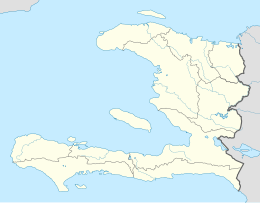Gonâve Island
| Native name: Île de la Gonâve | |
|---|---|

|
|
| Gonâve Island (Haiti) | |
| Geography | |
| Location | Gulf of Gonâve |
| Coordinates | 18°50′N 73°05′W / 18.833°N 73.083°WCoordinates: 18°50′N 73°05′W / 18.833°N 73.083°W |
| Area | 743 km2 (287 sq mi) |
| Highest elevation | 778 m (2,552 ft) |
| Highest point | Morne La Pierre |
| Administration | |
|
Haiti
|
|
| Department | Ouest |
| Largest settlement | Anse-à-Galets (pop. 39,783) |
| Demographics | |
| Population | 79,188 (2009 Off. Est.) |
| Pop. density | 134.59 /km2 (348.59 /sq mi) |
|
Haiti
|
|
| Location | Gonâve Island Haiti |
|---|---|
| Coordinates | 18°41′38.7″N 72°49′22.1″W / 18.694083°N 72.822806°W |
| Foundation | concrete basement |
| Construction | metal skeletal tower |
| Tower shape | square pyramidal tower with balcony and light |
| Markings / pattern | white tower |
| Height | 20 metres (66 ft) |
| Focal height | 15 metres (49 ft) |
| Light source | solar power |
| Range | 9 nautical miles (17 km; 10 mi) |
| Characteristic | Q (6) + L Fl W 15s. |
| Admiralty number | 14184 |
| NGA number | J5384 |
Gonâve Island (French: Île de la Gonâve, pronounced: [ɡɔ.nav]; also La Gonâve) is an island of Haiti located west-northwest of Port-au-Prince in the Gulf of Gonâve. It is the largest of the Hispaniolan satellite islands. The island is an arrondissement (Arrondissement de La Gonâve) in the Ouest and includes the communes of Anse-à-Galets and Pointe-à-Raquette. The indigenous Taínos called the island Guanabo.
Made up of mostly limestone, the reef-fringed island of Gonâve is 60 km (37 mi) long and 15 km (9.3 mi) wide and covers an area of 743 km2 (287 sq mi). The island is mostly barren and hilly with the highest point reaching 778 m (2,552 ft). The island receives between 800 mm (31 in) to 1,600 mm (63 in) of rain a year, higher elevations representing the latter figure.
The barren, dry nature of the soil has long prevented agricultural development on the island and kept the population lower than it otherwise might have been. During the colonial period, the island was uninhabited by colonists, which led the indigenous Taínos to seek refuge there after early battles with the Spanish. Runaway slaves in the French period, too, sometimes sought out the island for a place to hide from their owners on the mainland.Overgrazing and over-exploitation of water resources affect the island's current residents.
...
Wikipedia


